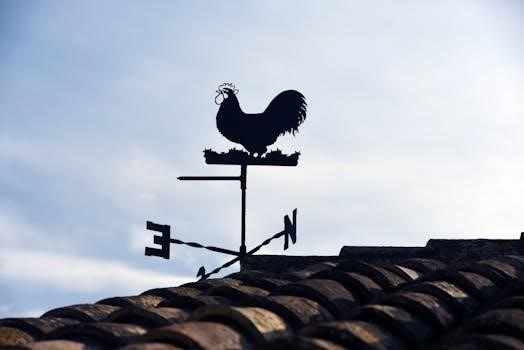
Title⁚ Old MacDonald Had a Farm⁚ Lyrics‚ History‚ and Educational Value
This classic children’s song‚ “Old MacDonald Had a Farm‚” is a staple in early childhood education․ Its repetitive structure and focus on animal sounds make it highly engaging for young learners․ The song promotes language development and introduces children to farm animals․ Numerous versions and adaptations further enhance its educational appeal․
“Old MacDonald Had a Farm” is a beloved nursery rhyme that has captivated generations of children․ This simple‚ yet incredibly effective‚ song introduces young minds to the concept of a farm and the various animals that inhabit it․ The repetitive structure of the lyrics‚ combined with the fun animal sounds‚ makes it easy for children to learn and sing along․ The song’s engaging nature also contributes to its widespread popularity in early childhood education settings․ It serves as an excellent tool for language development‚ auditory skills‚ and musical appreciation․ The familiar melody and predictable structure create a sense of comfort and security for children․ Furthermore‚ the interactive element of mimicking animal sounds and movements makes learning an active and enjoyable experience․ The enduring appeal of this song speaks to its fundamental role in children’s cultural and educational development․ Many families and educators rely on it as a fundamental part of early learning experiences․ The lyrics‚ readily available in various formats‚ including PDF‚ ensure accessibility and continued enjoyment․
Core Lyrics and Variations
The core lyrics of “Old MacDonald Had a Farm” follow a basic pattern‚ beginning with the line‚ “Old MacDonald had a farm‚ E-I-E-I-O․” This refrain is the foundation upon which the rest of the song is built․ Each verse introduces a different animal found on the farm‚ accompanied by its characteristic sound․ For example‚ a verse might include a cow and its “moo-moo‚” or a pig and its “oink-oink․” The “E-I-E-I-O” refrain is repeated after each animal is introduced‚ creating a memorable and predictable structure for children to follow․ While the fundamental structure remains consistent‚ numerous variations exist․ These variations often include different animals such as ducks with “quack quacks‚” sheep with “baa baas‚” or even more exotic animals․ This flexibility allows educators and parents to introduce a wide range of animal sounds and expand the educational value of the song․ The adaptability of the lyrics also makes it easy to tailor the song to different learning environments and cultural backgrounds․ These slight changes ensure that the song remains fresh and engaging for children‚ encouraging participation and imaginative play․ The availability of these lyrics in formats like PDF facilitates their use and sharing․
Historical Origins of the Song
The precise origins of “Old MacDonald Had a Farm” are somewhat unclear‚ with some sources suggesting it evolved from older folk songs․ One early version of the song‚ known as “In the Fields in Frost and Snow‚” appeared in a 1706 English opera by Thomas d’Urfey․ However‚ it’s unknown whether d’Urfey composed it or adapted a pre-existing folk tune․ This earlier version suggests the song has deep roots in oral tradition‚ passed down and modified over generations․ The familiar “E-I-E-I-O” refrain‚ while now integral to the song‚ might be a later addition or a local variation that gained widespread popularity․ Over time‚ the song migrated across the Atlantic‚ becoming a popular staple in American children’s culture․ The lyrics were further adapted to reflect the types of farm animals commonly found in different regions․ The shift from its earlier form to the now-ubiquitous version underscores the organic way folk songs evolve․ Its evolution reflects different cultural contexts and the changing experiences of rural life․ The enduring nature of the song speaks to its inherent appeal and ability to resonate across generations; The lack of a single definitive origin adds to the mystique and charm surrounding this beloved children’s classic․

Popularity and Cultural Impact
“Old MacDonald Had a Farm” has achieved immense popularity‚ becoming a cultural touchstone for children worldwide․ Its simple structure and repetitive lyrics make it easy for young children to learn and sing along‚ contributing to its widespread adoption in homes and early childhood settings․ The song’s popularity transcends geographical boundaries‚ with versions existing in various languages‚ reflecting its universal appeal․ The tune is instantly recognizable‚ and the playful animal sounds make it an engaging experience for children․ The song’s cultural impact is evident in its presence in countless children’s books‚ animated shows‚ and educational materials․ It has been covered by numerous artists across diverse musical genres‚ from folk to rock‚ further solidifying its place in popular culture․ The simplicity of the song allows for endless variations‚ with families and teachers often adding their own animals and sounds to personalize it․ This adaptability ensures the song remains fresh and relevant for each new generation․ Its enduring popularity demonstrates its effectiveness as both an entertaining and educational tool‚ cementing its role as a beloved children’s classic that crosses cultural and linguistic barriers․
Educational Benefits for Children
“Old MacDonald Had a Farm” provides a wealth of educational benefits for young children‚ making it a valuable tool in early childhood education․ The song introduces children to various farm animals and their corresponding sounds‚ fostering language development and vocabulary expansion․ The repetitive structure and simple lyrics enhance memory skills‚ as children learn to anticipate and sing along with the verses․ The interactive nature of the song‚ with its animal sounds and actions‚ encourages active participation and keeps children engaged․ Singing the song promotes phonological awareness‚ helping children recognize and manipulate the sounds in words‚ a crucial skill for literacy development․ The song also enhances auditory discrimination skills‚ as children learn to distinguish between different animal sounds․ Furthermore‚ the playful and fun nature of the song helps children develop a positive association with learning and singing․ Through this simple song‚ children are exposed to basic concepts about the natural world‚ specifically the farm environment and its inhabitants․ The adaptability of the song allows for the incorporation of different animals and sounds‚ further expanding the learning opportunities․ Overall‚ “Old MacDonald Had a Farm” serves as an effective educational resource that supports cognitive‚ linguistic‚ and social development in young children․
Animals Featured in Different Versions
The beauty of “Old MacDonald Had a Farm” lies in its adaptability‚ allowing for a diverse range of animals to be featured across various versions․ While the cow‚ pig‚ and duck are commonly included‚ numerous renditions introduce other farm inhabitants․ Sheep‚ with their “baa baa” sounds‚ are frequent additions‚ as are chickens‚ represented by “cluck cluck․” Horses‚ known for their “neigh neigh‚” also make appearances‚ expanding the animal vocabulary for children․ Some versions incorporate less common farm animals like turkeys‚ with their “gobble gobble‚” or even donkeys‚ which contribute a “hee haw” to the mix․ The specific animal selection often depends on cultural context and the learning goals of the educator or parent․ This variation allows for a broader understanding of farm life and the different sounds animals make․ The inclusion of diverse animals enriches the song’s educational value‚ exposing children to a wider spectrum of creatures․ Additionally‚ the flexibility of the song encourages children to invent their own verses‚ adding animals and sounds they find interesting․ The use of flashcards and puppets often accompanies the song‚ visually reinforcing the connection between the animal and its sound‚ further solidifying the learning experience․ This adaptability makes “Old MacDonald Had a Farm” a timeless and versatile tool for teaching about animals․
The “E-I-E-I-O” Refrain
The “E-I-E-I-O” refrain is arguably the most recognizable element of “Old MacDonald Had a Farm‚” serving as a catchy and memorable interlude between each verse․ Its nonsensical nature is precisely what makes it so appealing to young children‚ offering a playful rhythmic break from the animal sounds․ The repetition of “E-I-E-I-O” not only enhances the song’s musicality but also aids in developing a child’s understanding of rhythm and pattern․ This consistent refrain allows children to anticipate the coming verses‚ fostering a sense of engagement and participation․ Moreover‚ the “E-I-E-I-O” acts as a unifying element‚ tying the different animal verses together into a cohesive whole․ It creates a predictable structure that is easy for children to learn and sing along with‚ regardless of their familiarity with the specific animals mentioned in each verse․ The simplicity of the refrain makes it easily adaptable to various versions and languages‚ maintaining its core identity while incorporating diverse cultural and linguistic adaptations․ The “E-I-E-I-O” refrain also encourages movement and physical expression‚ as children often clap‚ sway‚ or dance along with the rhythm․ This kinesthetic aspect further enhances the learning experience‚ making it a holistic and enjoyable activity for children of all ages․

Printable Lyrics and Resources
Numerous online resources offer printable lyrics and accompanying materials for “Old MacDonald Had a Farm‚” making it easy for parents‚ teachers‚ and caregivers to utilize the song in educational settings․ These printable resources often include large‚ clear text versions of the lyrics‚ ideal for sing-alongs with young children․ Some resources also feature illustrations of the various farm animals mentioned in the song‚ aiding visual learners and enhancing the overall engagement․ Furthermore‚ many sites provide free downloadable PDF files containing the lyrics‚ making them readily accessible for both home and classroom use․ Beyond just lyrics‚ these resources may also include interactive elements like coloring pages of farm animals or cut-out puppets for children to act out the song․ The availability of these printable materials enhances the song’s versatility‚ allowing for various activities that cater to different learning styles․ Teachers can use the lyrics for classroom lessons‚ parents can utilize them for bedtime sing-alongs‚ and caregivers can incorporate them into play sessions․ The combination of text and visuals in these resources helps children learn the words and associate them with the corresponding animals and sounds․ This multi-sensory approach further reinforces the educational value of “Old MacDonald Had a Farm‚” making it a rich learning tool that is both accessible and fun․
Musical Adaptations and Covers
“Old MacDonald Had a Farm” has seen countless musical adaptations and covers across various genres‚ showcasing its enduring appeal․ From simple acoustic renditions to lively‚ upbeat versions‚ the song’s melody has been reinterpreted by numerous artists․ Many contemporary children’s musicians have included it in their albums‚ often with added instrumentation and harmonies․ Some adaptations introduce new tempos or rhythms‚ giving the song a fresh and modern feel‚ while staying true to its core․ Beyond children’s music‚ some jazz and pop artists have also covered the song‚ experimenting with different arrangements and stylistic approaches․ These covers often feature more complex instrumentation and vocal harmonies‚ targeting a broader audience․ The song has also been adapted for different musical instruments‚ with versions available for piano‚ guitar‚ and ukulele‚ making it accessible for budding musicians․ Some covers include unique sound effects to imitate the animal sounds‚ adding another layer of creativity to the song․ The diverse range of adaptations illustrates the song’s versatility and adaptability to different musical styles and preferences․ These variations not only expose children to different musical genres but also provide a great platform for musical education‚ making learning fun and engaging․

Foreign Language Versions
“Old MacDonald Had a Farm” has transcended language barriers‚ with numerous adaptations available in various foreign languages․ These versions not only maintain the core melody but also translate the animal names and sounds into different linguistic contexts․ The French adaptation‚ for instance‚ teaches children the names of barnyard animals in French‚ such as “canard” for duck and “cochon” for pig‚ along with their respective sounds․ Similar versions exist in Spanish‚ German‚ and many other languages‚ offering a valuable tool for early language learning․ These multilingual versions enable children to connect familiar concepts with new linguistic expressions․ The repetitive structure and clear pronunciation in these adaptations make it easier for young learners to grasp new vocabulary․ Moreover‚ these foreign language versions introduce children to different cultures and their unique approaches to animal sounds․ This exposure to diverse languages and cultures promotes an appreciation for linguistic variety and enhances global awareness․ The use of a familiar tune also provides a comfortable context for introducing foreign language elements‚ making the learning process less daunting for young children․ The adaptability of “Old MacDonald” to other languages demonstrates its universal appeal and educational potential․
Use in Early Childhood Education
“Old MacDonald Had a Farm” is a powerful tool in early childhood education‚ serving multiple developmental purposes․ The song’s simple‚ repetitive structure makes it easy for young children to learn and memorize‚ promoting language acquisition and phonological awareness․ By singing along‚ children practice pronunciation and build vocabulary related to farm animals and their sounds․ The interactive nature of the song‚ often involving actions and mimicking animal noises‚ enhances engagement and sensory learning․ Teachers use this song to introduce animal names‚ teach sound recognition‚ and encourage imaginative play․ The adaptable nature of “Old MacDonald” allows educators to modify it to suit different learning objectives‚ including counting‚ rhyming‚ and introducing new vocabulary․ The song also serves as a foundation for thematic learning about farms‚ agriculture‚ and animal habitats․ Furthermore‚ “Old MacDonald” is often used to foster social interaction through group singing and movement activities․ The enjoyable and familiar melody creates a fun learning environment‚ making it an invaluable resource in early childhood classrooms․ Its adaptability and versatility make it a cornerstone in many educational settings․



